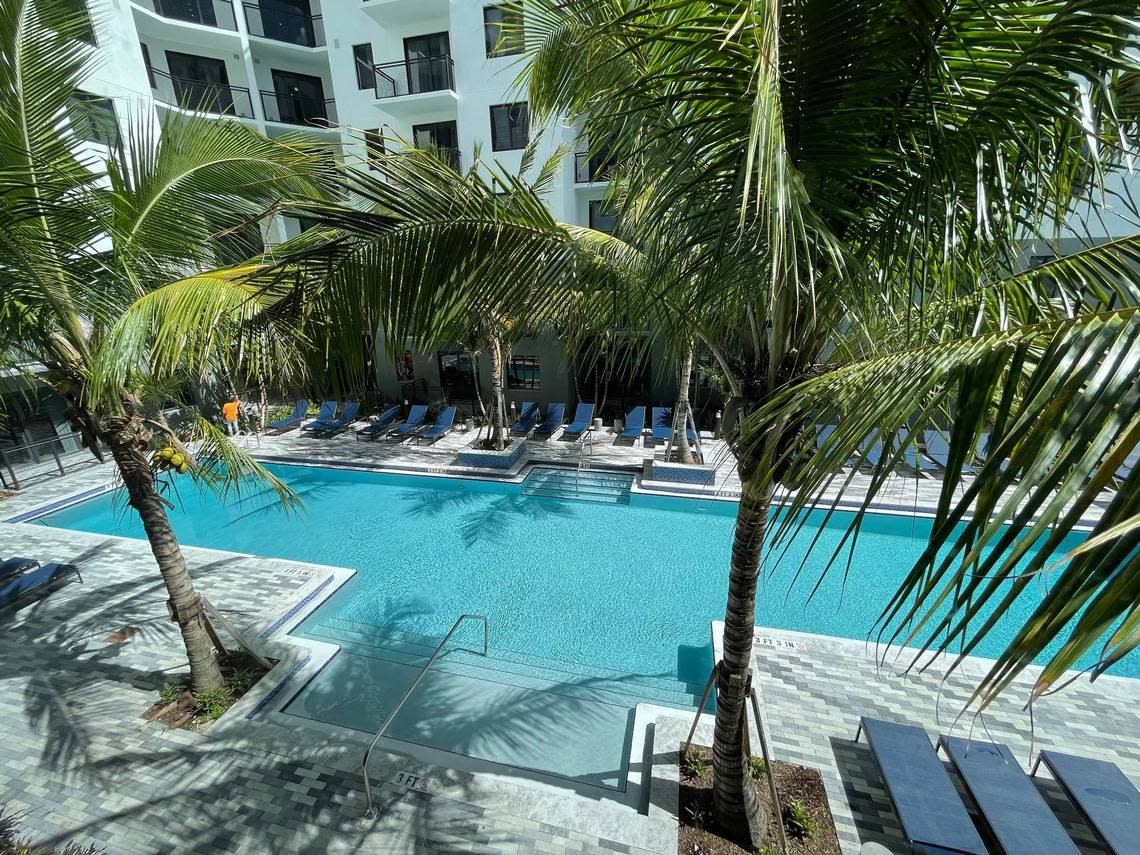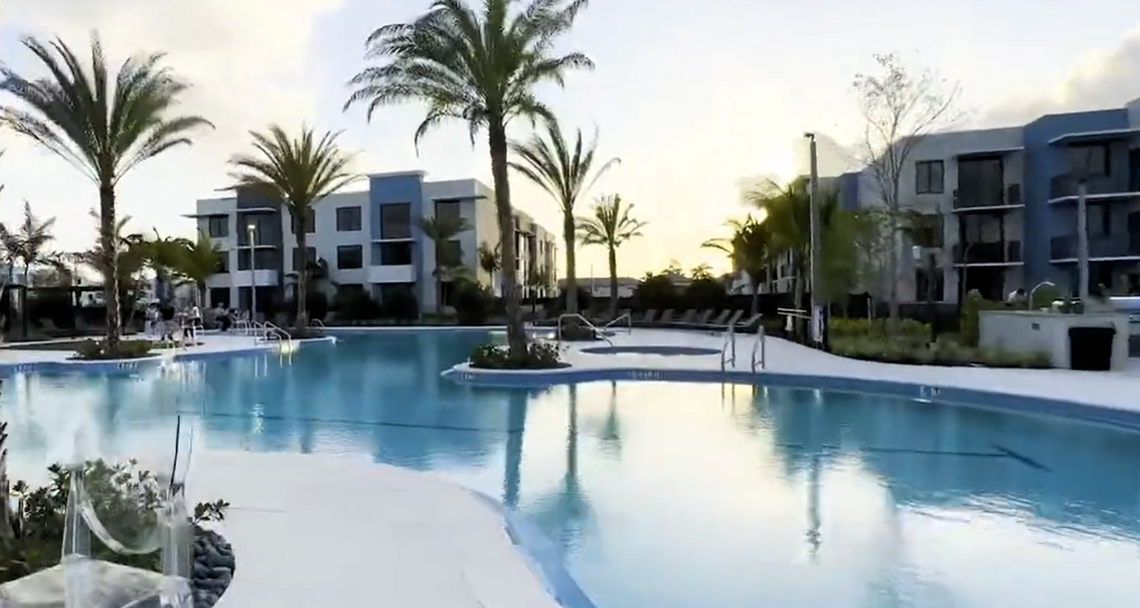Struggling to stay in Hialeah: Evictions surge in new luxury enclaves
Jessica Mora moved to Hialeah two years ago with her husband and her daughter to a two-bedroom apartment in Pura Vida, one of the city’s newest developments on Okeechobee Road.
The monthly rent for Mora’s unit initially stood at $2,150. However, upon lease renewal, a major $700 increase catapulted the rent to $2,850 — a sharp blow to her already-strained finances.
As the year drew to a close in 2023, Mora faced the added turmoil of separation from her husband, further destabilizing her financial footing. Left grappling with the aftermath, she found herself in urgent negotiations with building management to pay the rent.
Yet, just two months later, in January 2024, the building’s legal team initiated eviction proceedings — a daunting escalation in Mora’s struggle to maintain a roof over her head.
An el Nuevo Herald analysis of public records from Miami-Dade court shows that Hialeah’s three largest and most modern buildings, Pura Vida, Shoma Village and Manor Hialeah, together have filed a total of 165 complaints for residential eviction within the last 20 months.
“South Florida is unlivable. We are just surviving in Hialeah,” said Mora, a 36-year-old Venezuelan.
A decade ago, she embarked on her journey of immigration, making her first home in Homestead, where she nurtured her young daughter through her early years. When circumstances evolved, the family moved to Doral, but soon that too became untenable. Mora had to move again to a city she believed offered affordability, such as Hialeah.
Now, she is considering returning to Homestead, where her daughter’s paternal grandparents live. She might even leave South Florida, with her sights set on Jacksonville.
As a result of the lawsuit, she is paying each month’s rent in court while waiting anxiously for her lease to end on May 31. Her case is not the only one.
These buildings, marketed as “luxury apartments,” offer uncommon amenities in Hialeah, including swimming pools, gyms, conference rooms, and barbecue areas.
But this housing boom has precipitated a surge in rental prices, with rates ranging from $2,050 for a studio unit to $3,765 for a three-bedroom apartment. This stark reality stands in contrast to the economic landscape of Hialeah, where predominantly working-class residents take home an average family income of about $49,000 annually.

These expansive urban complexes are not only increasing rental rates within their confines but also exerting pressure on surrounding areas, despite being comparatively modest properties. This phenomenon is reshaping the financial landscape for a majority of residents.
Local politicians have consistently justified Hialeah’s urban transformation, citing the need to cater to a demographic shift of young professionals who had previously sought more contemporary living options akin to those found in Miami.
However, can the existing community afford these escalating rents?
Hialeah struggling with affordability
Public records show that Manor Hialeah, the newest property, made up of 642 units and located in the Amelia district, has evicted 16 families of the 45 complaints in eight months, an average of two tenants per month.
Alex Smith lived there but preferred to move to an old building in North Miami.
“It is extremely expensive to live in Hialeah,” he said. “Although there are many amenities, the price of an apartment is ridiculous. We are not in South Beach.”

Meanwhile, in Shoma Village, a two-tower structure with 304 units, 13 families have been evicted. The property, located on Hialeah Drive, has filed 70 eviction complaints.
In the case of Pura Vida, the 260-unit building where the Venezuelan mother lives, 50 eviction cases have been filed in court. Nineteen evictions have been completed in 17 months, which represents 38% of the total complaints at the building, according to records.
“The Pura Vida property manager is doing everything possible to remove the people who are here. Many have already been evicted,” Mora argued.
After saying they would respond by email, Pura Vida’s property manager did not answer el Nuevo Herald’s questions.
Reached by phone, managers at Manor Hialeah and Shoma Village said they had no comment on the eviction lawsuits at their properties.
One of Pura Vida’s developers, Michael Wohl, a principal of Coral Rock Development Group, told el Nuevo Herald that he was very surprised to hear Mora’s statements and assured that as a member of the Affordable Housing Committee in Hialeah, he is working to find a solution to the crisis.
In Wohl’s opinion, an alternative would be to build mixed-use housing, a portion at market price and another at a price accessible to workers.
Serial evictions, a ‘pressure’ strategy
According to data from The Eviction Lab, a housing research group at Princeton University, there have been more than 3,188 eviction lawsuits in Hialeah between 2020 and mid-2023.
Juan Pablo Garnham, spokesperson for The Eviction Lab, told el Nuevo Herald that in the southern United States, particularly in Florida, there is a trend of “serial evictions.”
“Many landlords do not use eviction lawsuits to recover rent money, but rather it is a strategy to pressure tenants to leave by filing a lawsuit against the same family or individual several times in a year,” Garnham said.
The data analyzed from Miami-Dade civil court show that each of the three new developments in Hialeah repeatedly sued the same tenant.
Shoma Village has sued 20 tenants on more than one occasion, including three times in one year, making up a total of 44 of the 70 complaints it has filed to date.
Pura Vida sued seven people multiple times, for a total of 24 of the 50 lawsuits in court, while Manor Hialeah filed a total of 17 complaints against six tenants, out of the 45 cases in court.
Most of the complaints for the three properties were dismissed after the tenants paid their debts. However, public data show that more than 30% of these complaints ended in eviction or vacancies before the order was issued.
Mayor Esteban Bovo Jr. warned that the government cannot intervene and stop these evictions, but he estimated that if real estate instability continues, at some point it will have to correct itself.
“If you have a building with empty units, because the price you are asking is too high, and it has been proven because they have had to remove people, sooner or later the owner of the building will have to correct it,” Bovo said in an interview with el Nuevo Herald.
Long-term impact of eviction
The fear of eviction following a formal complaint can have profound physical and psychological repercussions on individuals grappling with the economic pressure of meeting housing expenses, according to a study conducted by The Eviction Lab in December 2023.
The center has found a relationship between eviction and health and even premature death.
“If paying too much rent can increase your chances of dying prematurely, an eviction can be a fatal blow,” states the report, titled Rising rents and evictions linked to premature death.
The analysis revealed that merely facing the threat of eviction, even if it didn’t in an actual eviction, was correlated with a significant 19% surge in mortality rates.
“Receiving an eviction sentence was associated with a 40% increased risk of death,” the report explains.
Nelsy Nuñez de Mora, a 56-year-old resident of Hialeah, has endured firsthand the toll of housing instability. She recounts how her health has deteriorated under the shadow of eviction looming over her family’s three-bedroom unit at Pura Vida.
“Our ordeal began with a court summons merely five days after a missed payment. With my husband’s job loss and my own health constraints preventing me from working, our situation grew dire,” Nuñez lamented. Living with her husband, youngest daughter, son-in-law, and two grandchildren, the burden of an eviction threat weighed heavily upon them.
They moved into their unit in 2022 and paid $2,300 in monthly rent. Then the rent surged to $3,160 per month.
“The manager’s cold ultimatum — ’Pay up or leave’ — offers no solace. Breaking the lease would impose a hefty two-month penalty,” she said, her voice tinged with resignation.
Compounding their distress, Nuñez battles fibromyalgia, and she has had multiple ischemic strokes.
“The toll is evident — seizures, debilitating weakness, and loss of mobility plague my left side. Each day brings new blackouts, all fueled by the relentless stress,” she confided.
In 2018, her family fled Venezuela due to political persecution against Nuñez’s husband, Carlos Mora. Once prosperous merchants, they are now thrust into a world of uncertainty in Hialeah.
These dozens of cases filed in court will impact these families even if they reach an agreement with their landlords avoiding eviction. The public records on the eviction proceedings will make it much more difficult to find housing in the future, experts predict.
“The case will always appear on the eviction record, but it will show that it has been dismissed, although only some will search the file to find out the verdict,” explained Jeffrey M. Hearne, director of litigation at Legal Services of Greater Miami, an organization that provides free legal services.
